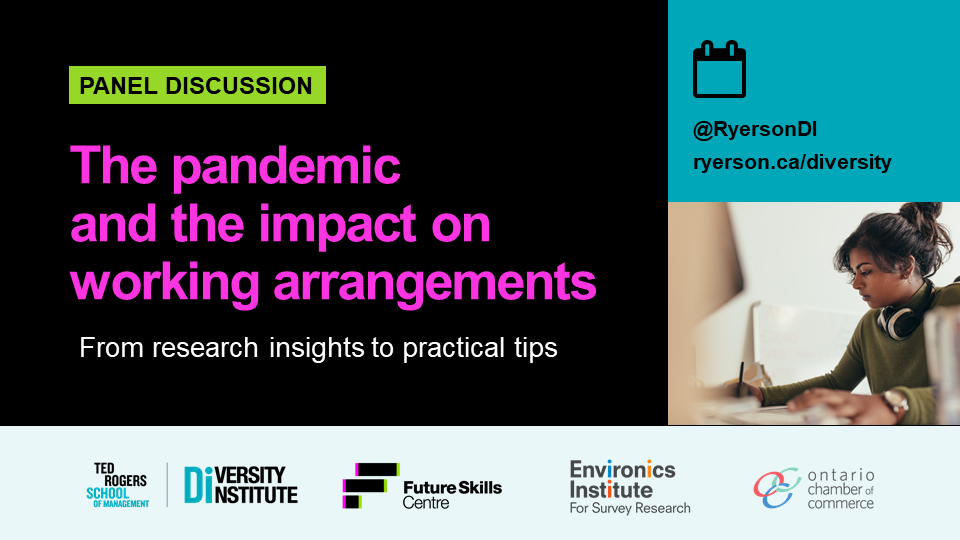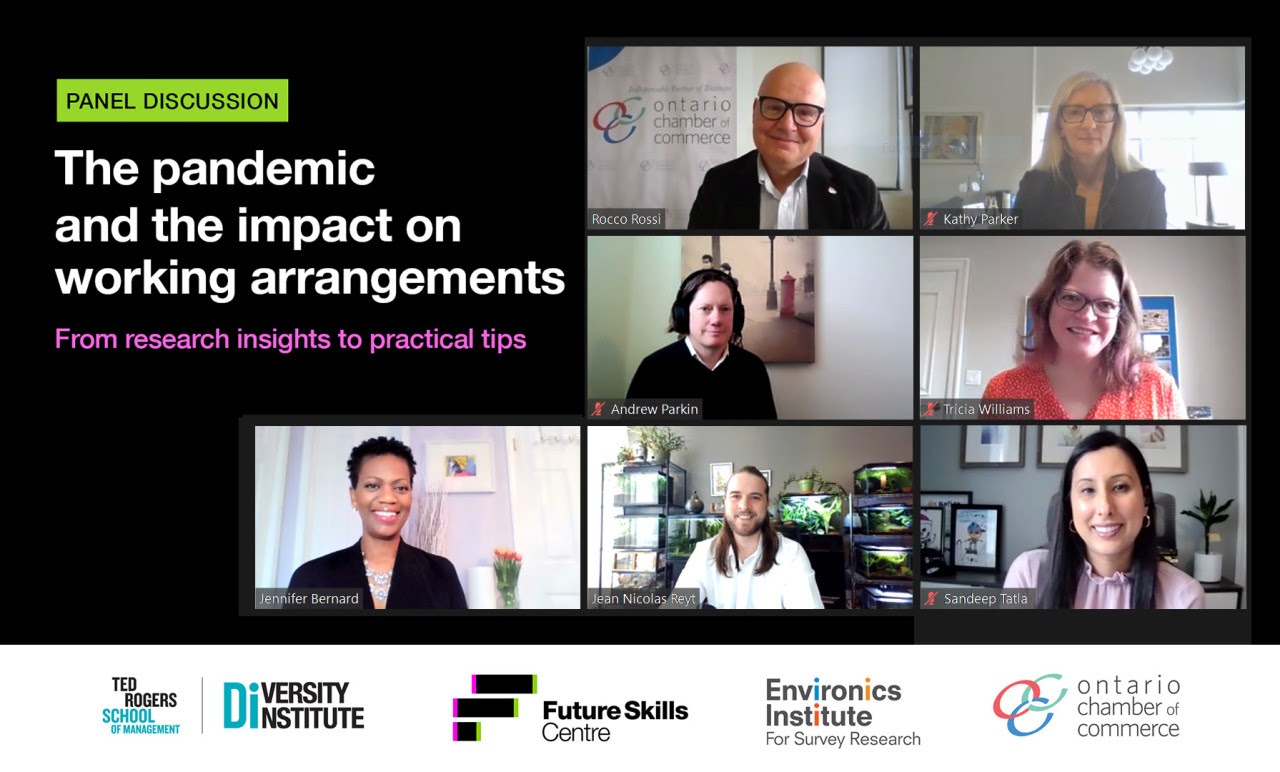The Pandemic and the Impact on Working Arrangements

The COVID-19 pandemic has intertwined our work and home lives in ways never before seen. How companies view flexible work arrangements has fundamentally changed while exciting opportunities around flexible hours, four-day workweeks, and job sharing have come to light. Emerging research is developing an understanding of how Canadians have been affected by, and are coping with, the disruptions caused by the pandemic while working from home.
A new survey conducted by the Environics Institute for Survey Research (external link) , in partnership with the Diversity Institute and the Future Skills Centre (external link) , shows that the shift has had uneven effects on different segments of the population. High-skilled and higher-income groups tend to have fared relatively well. At the same time, pre-existing barriers facing marginalized individuals have generally grown taller, and the skills and labour gap has grown wider.
We recently joined the Future Skills Centre and the Environics Institute to present a first look at the results of the survey during a discussion of the impacts the COVID-19 pandemic has had on working arrangements hosted by the Ontario Chamber of Commerce (external link) (OCC).
Rocco Rossi (external link) , President and CEO of the OCC, suggested that we are in the midst of an incredible societal experiment in which large portions of the population are working from home. Rossi underlined the importance of this research as the country cautiously turns to post-pandemic recovery. It encourages critical questions, Rossi explained, like “How do we use data to make better decisions?”
Andrew Parkin (external link) , Executive Director at the Environics Institute, introduced analysis of survey responses from over 5,300 Canadian adults to set the foundation for the discussion. There are two types of inequality that emerge in the data, Parkin explained:
- Who has the option of working from home?
- Who is more adversely affected by the experience of working from home?
White collar workers, like those who traditionally work in offices and in clerical roles, are much more likely to be working from home compared to those who work in sales and service, skilled trades, and manual labour. The lines are also drawn along income lines, Parkin noted. The higher one’s income, the more likely it is that they were able to work from home throughout the pandemic, and by extension, minimize their risk of contracting the virus. Workers who are not able to do their jobs from home have been forced to jeopardize their health in order to earn their next paycheck. “Those who are economically vulnerable end up being more vulnerable to the pandemic itself,” Parkin said.
Notably, people working from home were more likely to agree with positive statements about working from home versus negative ones. For instance, seven out of ten respondents agreed with the statement, “Once the pandemic is over, my employer should continue to allow me to work from home.” Further, those who do report facing challenges working from home nonetheless feel positive about the arrangement as a whole, Parkin explained. These insights raise questions about how accommodating workplaces were before the pandemic.
The data shows that individuals working from home who also have young children in the home are more common to report negative experiences. Younger workers, especially those who recently completed their educational pursuits, are much more likely than those in their core working years to worry about the impacts of work from home arrangement on their careers. Immigrants, racialized workers, and workers with a physical or mental condition or difference that limits their daily activity are also concerned that work from home arrangements will negatively impact their careers, and a considerable number are more likely to report that they do not have access to the right computer equipment or software to allow them to do their jobs correctly.
“This is a real signal about the potential for the experience of working from home to widen pre-existing inequalities in the workplace. Those who were already further away from the power centre—or from the centre of decision-making—those who were already further away before the pandemic, are more likely to worry that being out of the office will keep those barriers in place,” Parkin said.
Organizational Leadership in a New World of Work

“What does the situation require of us going forward?” asked Tricia Williams (external link) , Director of Research, Evaluation and Knowledge Mobilization at the Future Skills Centre, and moderator of the event’s practical discussion with experts in organizational leadership.
Jean-Nicholas Reyt (external link) , Assistant Professor of Organizational Behavior at McGill University, recalled the highly lauded promise of technology-enabled work from home arrangements, then-called telecommuting in the 1990s. Yet remote work remained the exception to the rule for most Canadians until the COVID-19 pandemic hit. Reyt explained that while the latest research reveals many areas that need to be closely examined and improved, the increase in remote work has been positive for many in the workforce. “A lot of people are realizing now, managers and employees, that remote work could be part of the arsenal of different work arrangements,” Reyt explained.
But the speed at which remote work needed to be implemented across the country to curb the spread of COVID-19 presented its own challenges. “It was building the plane while flying the plane. We had to learn our lessons quickly...and we had to adapt very quickly,” explained Jennifer Bernard (external link) , President & CEO of Women’s College Hospital Foundation. The challenge leaders and managers now face is in guiding teams through unprecedented new waters. There is a profound loss of equity, and a profound loss of privacy as boundaries between work and life blur, Bernard explained. “We needed to find new ways to engage, new ways of speaking to people, and new ways of extending ourselves—especially to introverts,” she said.
78% of CEOs surveyed by PwC Canada believe the shift to remote work is enduring, while 61% of those believe that these trends are here to stay, explained Kathy Parker (external link) , a Partner at PwC. One positive development Parker sees is increased attention on employee wellness, and more recognition of the value of effective wellness programs than ever before.
“We have been allowed to share a little more of our humanity in the workplace,” Sandeep Tatla (external link) , Chief Equity, Diversity and Inclusion Officer at Fasken, explained. Renewed focus on health and the stresses of working from home, in addition to global racial justice movements, have helped to introduce important conversation into the workplace. What has become clear, Tatla explained, is that a one-size-fits-all approach to wellness does not work. “When we think about wellness we need to understand that different groups of people experience the world differently, so their wellness needs may be different,” Tatla said.
“Leaders have a choice between trying to apply old models, old ways of thinking, or trying to apply new models of thinking,” Reyt explained. Bernard added that those leaders who have been able to adapt most quickly to the changing needs of their teams have found the most success.
However, leading a remote team is not intuitive, Parker noted. She asked how managers can be equipped with the skills they need to be effective leaders in this new world. Tatla questioned how leaders can help employees feel a sense of belonging in their workplaces when social interactions are significantly limited. Panelists agreed that it will require a radical rethinking of work, productivity, and leadership, and more research is needed.
Bernard believes that we are still in the midst of “a big experiment,” so it is not yet clear what works. At Bernard’s organization, employees are provided with the opportunity to do work to improve and sustain their mental health during work hours. It is also important, Bernard explained, to think about who leads mental health discussions within an organization. While the most senior members tend to lead these conversations, it is often the people in junior positions who are struggling the most, Bernard explained.
Research shows that in remote work environments, communication between managers and employees devolves into almost entirely task-based discussions, Reyt noted. It is essential for leaders to open individualized lines of communication with employees beyond this, Reyt explained, and illuminate the bigger picture as workers may struggle to see how their efforts fit into larger organizational goals. Parker added that leaders need to adapt their thinking from one that is entirely output-based to one that is outcome-based as work continues in flexible arrangements during and post-pandemic. For Tatla and Bernard, it is important for leaders to establish trust with their employees through transparency and vulnerability, and model behaviours that they hope to see from their teams.
Each organization, panelists stressed, will require custom solutions that meet the particular needs of its staff, balancing organizational goals with the health and wellbeing of those working to reach them. It is critical to constantly be willing to learn and look at where people are falling through the gaps, and examine what proves successful to continually evolve, Bernard explained.
Connect with the Diversity Institute
Subscribe (external link) to our mailing list and follow us on Twitter (external link) and LinkedIn (external link) to stay up-to-date on the latest events, research and initiatives from the Diversity Institute.